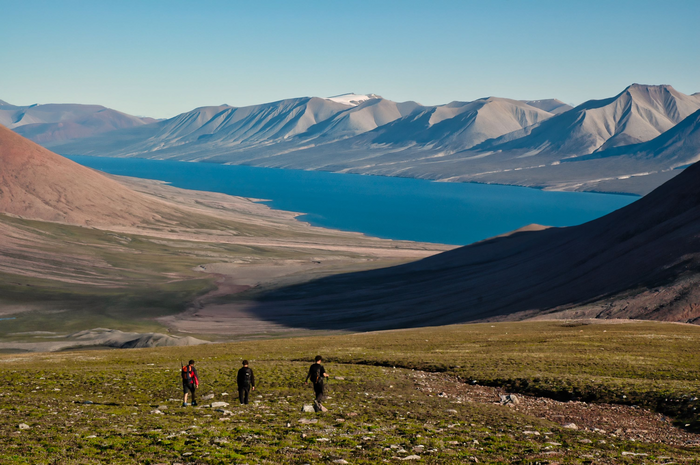Yet that is also when the world got the trees and complex land plants similar to those we know today first evolving and spreading across the landscape. Those complex root systems affected soil biogeochemistry and set off part of the chain that allowed humans to thrive.
It has been proposed that plant evolution and root development occurred so rapidly and on such a massive scale that nutrient export from the land to the ancient oceans would have drastically increased. This scenario is seen in modern systems where anthropogenically sourced nutrient export has vastly increased the nutrient load into areas such as the Gulf of Mexico and the Great Lakes, leading to large-scale algal blooms that ultimately deplete the oxygen in the water column. This effect, known as eutrophication, magnified on a global scale, would have been catastrophic to ancient oceans, fueling algal blooms that would have depleted most of the ocean’s oxygen.

Ymer Island, Greenland, during the collection of the Heintzbjerg sample sequence used in this study. In the foreground looking down the slope is the Zoologdalen Formation. The body of water is the Dusen Fjord, which separates the northern and southern portions of Ymer Island. Photo by John Marshall, University of Southampton.
The episodic nature of plant expansion could help explain why there are at least six significant marine extinctions in the Devonian. The key to linking mass extinctions and the expansion and radiation of land plants lies in identifying a nutrient flux elevated above background levels, linking that nutrient flux to either indirect or direct evidence of the presence of deeply rooting land plants and finally showing that this phenomenon occurred in multiple locations and times.
A new study was able to do precisely that by utilizing geochemical records from ancient lake deposits in Greenland, northern Scotland, and Orkney. Utilizing lake records, elevated values of the nutrient phosphorus were detected in five distinct locations during the height of plant evolution and expansion in the Devonian. In each case, elevated values of nutrient input were coincident with evidence of the presence of early trees in the form of fossilized spores and, in some cases, fossilized stems of the earliest deeply rooting tree, Archaeopteris. In two cases, that evidence coincided with a Devonian marine extinction event, including the most significant Devonian mass extinction, the Frasnian–Famennian extinction (also known as the Late Devonian mass extinction).
The authors also linked the periodic wet/dry climate cycles known to exist in the region during the Devonian with specific episodes of plant colonization. While elevated nutrient export was noted during both wet and dry climate cycles, the most significant export events occurred during wet cycles, suggesting that plant expansion was episodic and tied to climate cyclicity.
While the scope of this study was limited to a single geographic region, it is likely that these events occurred throughout the Devonian Earth. The colonization of different types of land plants in different regions and at different times would have resulted in episodic nutrient pulses significant enough to sustain eutrophication and cause (or at least contribute) to the numerous marine extinction events throughout the mid- to Late Devonian.






Comments